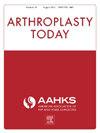Coronal Alignment in Revision Total Knee Arthroplasty: A Comparison of Cemented Vs Press-Fit Stems for Restoring Mechanical Axis
IF 2.1
Q3 ORTHOPEDICS
引用次数: 0
Abstract
Background
Restoring a neutral coronal alignment in revision total knee arthroplasty (rTKA) is paramount. Stem length and fixation type influence final limb alignment. This study compared overall limb alignment, measured by hip-knee-ankle (HKA) angle, in revisions using short-cemented (<75 mm), long-cemented (>75 mm), and press-fit stems. Secondary aims included evaluating coronal and sagittal alignment of tibial and femoral components and assessing canal fill ratio (CFR) in the press-fit group.
Methods
A retrospective multicenter review of 124 rTKAs from January 2019 to January 2022 was conducted. Included cases had revision of both femoral and tibial components using stems, with postoperative weight-bearing radiographs. Patients were divided into 3 groups based on stem type. Radiographic assessments included HKA, mechanical lateral distal femoral angle (mLDFA), mechanical medial proximal tibial angle (mMPTA), and CFR. analysis of variance and chi-square tests were used for statistical analysis.
Results
Data from 81 rTKAs were analyzed. Mean HKA was similar across all groups (group A: 178.9°, group B: 178.7°, group C: 178.7°; P = .985). No significant differences were found in mLDFA or mMPTA between groups. However, mLDFA showed more variability than mMPTA (P = .021), indicating greater femoral alignment deviation. CFR in press-fit stems averaged 77.3%, with no significant side-to-side differences.
Conclusions
Short-cemented stems achieved alignment comparable to long-cemented and press-fit stems. Femoral alignment was more variable than tibial. Short-cemented stems provide a flexible option with reliable alignment outcomes.
改良全膝关节置换术中的冠状面对齐:骨水泥与压合假体修复机械轴的比较
背景:在全膝关节翻修成形术(rTKA)中,恢复中性冠状位排列是至关重要的。茎长和固定方式影响最终的肢体对中。本研究比较了使用短骨水泥(< 75mm)、长骨水泥(> 75mm)和压合式骨水泥进行翻修时,以髋关节-膝关节-踝关节(HKA)角度测量的整体肢体对齐情况。次要目的包括评估胫骨和股骨组件的冠状面和矢状面对齐以及评估压合组的管填充率(CFR)。方法对2019年1月至2022年1月124例rtka进行回顾性多中心评价。纳入的病例使用假体对股骨和胫骨假体进行翻修,并进行术后负重x线片检查。根据干细胞类型将患者分为3组。影像学评估包括HKA、机械股骨外侧远端角(mLDFA)、机械胫骨内侧近端角(mMPTA)和CFR。采用方差分析和卡方检验进行统计分析。结果对81例rtka的数据进行分析。各组平均HKA相似(A组:178.9°,B组:178.7°,C组:178.7°,P = .985)。两组间mLDFA和mMPTA无显著差异。然而,mLDFA比mMPTA表现出更多的变异性(P = 0.021),表明更大的股骨对准偏差。压合杆的CFR平均为77.3%,两侧无显著差异。结论:短骨水泥支架与长骨水泥支架和压合支架的对准效果相当。股骨对线比胫骨对线变化更大。短胶结阀杆提供了灵活的选择和可靠的对准结果。
本文章由计算机程序翻译,如有差异,请以英文原文为准。
求助全文
约1分钟内获得全文
求助全文
来源期刊

Arthroplasty Today
Medicine-Surgery
CiteScore
2.90
自引率
0.00%
发文量
258
审稿时长
40 weeks
期刊介绍:
Arthroplasty Today is a companion journal to the Journal of Arthroplasty. The journal Arthroplasty Today brings together the clinical and scientific foundations for joint replacement of the hip and knee in an open-access, online format. Arthroplasty Today solicits manuscripts of the highest quality from all areas of scientific endeavor that relate to joint replacement or the treatment of its complications, including those dealing with patient outcomes, economic and policy issues, prosthetic design, biomechanics, biomaterials, and biologic response to arthroplasty. The journal focuses on case reports. It is the purpose of Arthroplasty Today to present material to practicing orthopaedic surgeons that will keep them abreast of developments in the field, prove useful in the care of patients, and aid in understanding the scientific foundation of this subspecialty area of joint replacement. The international members of the Editorial Board provide a worldwide perspective for the journal''s area of interest. Their participation ensures that each issue of Arthroplasty Today provides the reader with timely, peer-reviewed articles of the highest quality.
 求助内容:
求助内容: 应助结果提醒方式:
应助结果提醒方式:


